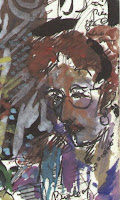STEAMING
Fabric that has been dyed with one of the direct dyeing techniques must be steamed. Heat and moisture complete the bond between dye and fiber. Steaming can be completed on small pieces of fabric by layering the fabric between pieces of newspaper so that no part of the fabric touches another part. The fabric and newspapers should be layered into a bundle and steamed on a rack in a large canning pot, or steamer. While steaming the bundle of fabric should not touch the sides of the pot or become moist in any way or staining will occur. The fabric should steam for about 45 minutes.
Rinse well in a good soap such as "Woolite" "Orvis Soap" or "Ivory Flakes". Do not rub or scrub the fabric but handle it gently at all times.
* From Cerulean Blue
DYE TESTS
Because natural dyes vary, it is important to test each batch of dye made, not only for color, but for light and wash fastness. The tests are quite easy to make and enable color differences to be judged and the reaction of the dyes to the different mordants and fibers.
Without having access to expensive machines the following information will be helpful for testing dyes.
COLOR TESTS
Cut small pieces of fabric about 1" x 2". Brush on or immerse in the dye, dry, brush on the mordant then steam. These small pieces should be kept as a record of the colors obtained from each dye batch. These tests can be taped to cards and marked with batch numbers, name of dye, mordant, number of dye applications, date, and source.
COLOR FASTNESS
The fastness or permanence of a dye is important. A dye must be fast to light, washing, and perspiration. The need for a particular kind of fastness depends on the use of the article to be dyed.
SIMPLE LIGHT TESTS
To test for light fastness, cut two 2 inch openings in each of two pieces of heavy cardboard. Tape a piece of dyed cloth to one and cover it with the other piece of cardboard so that the openings correspond. It is important that light come through the
fabric. Then place this in direct sunlight. After a week remove and compare the section
exposed to the sun with the covered portion. Then rate the piece.
To test for light fastness, cut two 2 inch openings in each of two pieces of heavy cardboard. Tape a piece of dyed cloth to one and cover it with the other piece of cardboard so that the openings correspond. It is important that light come through the
fabric. Then place this in direct sunlight. After a week remove and compare the section
exposed to the sun with the covered portion. Then rate the piece.
Excellent..................no change of color.
Good......................no appreciable change of color.
Fair........................appreciable, but not objectionable change of color.
Poor.......................objectionable change of color.
WASH TESTS
To test for fastness to washing, braid a dyed sample of the fiber with a similar sample of undyed fiber. Then put the sample in a mild soap such as "Woolite" " Orvis Soap" or "Ivory Flakes" and tepid water. Natural dyes should not be washed vigorously but handled gently. Rinse well. If after rinsing, the water has no color in it the dye is rated as good, If there is color in the rinse water, the dye is rated fair, If the undyedyarn is stained with color, the dye is rated poor to washing.
CARE OF DYED FABRICS
Washing requires some care. Do not wash natural dyed fabrics in the washing machine. The fabric should be dry cleaned or hand washed carefully.
To wash use a mild soap such as "Woolite" "Orvis Soap" or "Ivory Flakes". Do not leave the fabric in water for along time. Do not rub or wring the fabric. Roll in a towel to remove the excess water or spin dry in the washing machine. Dry in the open air. Do not dry the wet fabric in the dryer or out in the sun.





